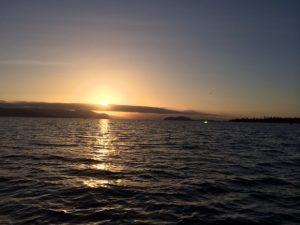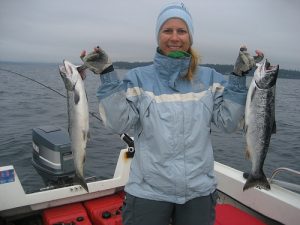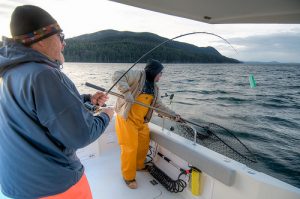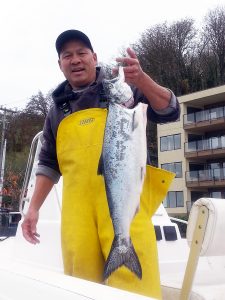Decent hatchery king action expected when central and northern Puget Sound opens this Sunday Leave a reply
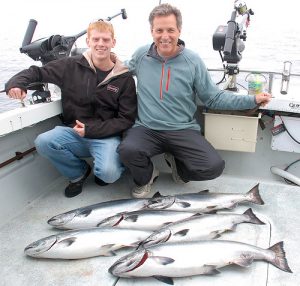
John Martinis, owner of John’s Sporting Goods in Everett and his son with a nice catch of hatchery kings from northern Puget Sound.
The inner-marine waterway salmon fisheries will begin in earnest this coming Sunday (July 16) when northern and central Puget Sound (Marine Catch Areas 9 and 10) open for the much anticipated hatchery king fishery.
“The increased quota for the mark-selective fishery is primarily due to the larger run size we forecasted, and there should be more hatchery chinook which extrapolates to good fishing,” said Ryan Lothrop, the state Fish and Wildlife Puget Sound recreational salmon manager. “I also think the mark rate will be pretty high.”
In northern Puget Sound the hatchery chinook catch quota is 5,599 compared to 3,056 in 2016; and central Puget Sound Sound will have a catch quota of 2,166 compared to 1,395 in 2016.
Both areas will be open for hatchery-marked kings this Sunday (July 16) through Aug. 15, but could close sooner if the catch quota is achieved.
On paper, the Puget Sound outlook for summer chinook shows an uptick with a forecast of 193,962 (166,235 are hatchery and 27,727 are wild) compared to 165,150 forecasted last summer.
“We feel pretty solid about this year’s salmon fisheries, and more comfortable than the past years,” Lothrop said. “We did a lot of double- and triple-checking on our forecasts, and there’s a lot more data on chinook that would make the forecast actually materialize.”
The hatchery jack chinook returns last year indicate a strong return of four-year-old chinook coming back this summer, which makes up the bulk of the sport catch.
A good portion of this summer’s chinook return originates from southern Puget Sound where 80,400 hatchery and 4,700 wild fish are predicted to arrive. A breakdown of major South Sound hatchery production includes 8,219 in Carr Inlet, 18,341 in Deschutes, 22,669 in Nisqually and 1,229 in Chambers Creek.
The northern Puget Sound chinook forecast is 53,209 with a slight improvement on Stillaguamish of 1,500 (500 last year); Snohomish is 8,200 (8,300); Skagit is 16,200 (15,500); Nooksack is 21,200 (27,900); and Tulalip is 5,300 (1,400).
If there is any indication on how catches could fare one should look at what is happening n fisheries right now in the Strait of Juan de Fuca, south-central Puget Sound, San Juan Islands and Strait of Georgia in British Columbia.
“Area 11 (south-central Puget Sound) has been solid lately,” Lothrop said. “There is some early evidence that folks are running into chinook in Area 10 (central Puget Sound which opened July 1 for hatchery coho only).”
Port Townsend typically gets off to a hot start, and since the area didn’t open early on July 1 for a coho only fishery that might make the bite decent.
King catches off Port Angeles have also been fairly good of late, fair to good in the San Juan Islands and very good in southern portions of B.C. waters with many of those fish being hatchery-marked kings. The positive news is those fish are most likely of Puget Sound origin since Canada doesn’t mass mark any of their kings.
“A couple of surprises we might have and I anticipate we’ll catch quite a few hatchery coho judging from the big numbers of coho we had seen this winter in South Sound,” Lothrop said. ‘I’ve also heard of reports of more pink salmon caught in Area 11 already.”
“For better or worse it is only a two salmon daily limit, and no bonus pink limits, but it will be realistic to get a limit of mixed salmon species and you won’t have to spend all day fishing,” Lothrop said. “The pink numbers will start to increase as the summer progresses and right out of the gate on July 16 anglers should consider getting some hatchery coho or pinks if the bite goes off for the kings.”
Look for thousands of anglers to turnout when inner-Elliott Bay opens for a three-day king fishery on Aug. 11-13. This fishery will allow a chance at 16,362 chinook destined for the Green River (13,988 are of hatchery origin). The inner-bay will be open Fridays to Sundays only from Aug. 18-20 and Aug. 25-27 for hatchery coho and pinks only. Places like Pier 86 in Elliott Bay and the Seacrest Boathouse Pier will also give up a fair share of kings during the summer, both of which are open Aug. 1 through Sept.15 with a one king daily limit.
The terminal hatchery-marked chinook and coho fishery in Sinclair Inlet is currently open through Sept. 30. In this area anglers will need to release wild chinook and coho from Aug. 1 through Sept. 15.
The summer hatchery king fishery has been anywhere from spotty to fairly good along the northern side of Vashon Island south to Tacoma since it opened on June 1. Dogfish have been a huge problem for baitfish anglers.
Places like Southworth, Dolphin Point, Point Robinson, Three Tree Point, Brace Point, Colvos Passage, outside of Gig Harbor, south side of Vashon Island and Point Defiance Park in Tacoma from the Clay Banks east toward the Slag Pile are all “good to go” fishing bets in the next couple of months especially later in August as the South Sound bound kings appear in bigger numbers.
Looking further ahead anglers should expect some decent coho fishing in central (Area 10) and south-central Puget Sound (Area 11), which will both be open through Oct. 31. It will be a hatchery-marked coho only fishery in central Sound while all coho and hatchery-marked chinook may be kept in south-central Puget Sound.
“I anticipate basically in Area 10 on southward ought to have good coho opportunity in late August , and September and October,” Lothrop said. “It will fare better than expected as there will be a lot of areas where the fish aren’t fished on (to the north) like they have in the past. There should be a good combination of opportunity for what the coho forecasts look like.”
This year’s Puget Sound coho return is 590,336 (300,696 are of hatchery origin and 289,640 are wild) compared to 255,403 (166,589 and 87,350) in 2016.
BY THE NUMBERS FOR 2016 NORTHERN PUGET SOUND (AREA 9)
(No two seasons are alike, but here is just a glimpse of how success fared last year during the selective hatchery-marked king fisheries)
July 16-17 – 1,520 boats with 3,416 anglers retaining 894 hatchery-marked chinook (six wild fish illegally kept), and released 2,003 hatchery-marked and 842 wild fish for a total estimated chinook encounter of 3,746.
July 18-24 – 3,058 boats with 6,186 anglers retaining 1,265 hatchery-marked chinook (three wild fish illegally kept), and released 2,833 hatchery-marked and 1,196 wild fish for a total estimated chinook encounter of 5,297.
July 25-31 – 1,930 boats with 3,967 anglers retaining 618 hatchery-marked chinook, and released 1,384 hatchery-marked and 586 wild fish for a total estimated chinook encounter of 2,588.
Aug. 1-4 – 742 boats with 1,342 anglers retaining 195 hatchery-marked chinook, and released 436 hatchery-marked and 185 wild fish for a total estimated chinook encounter of 816.
Season total from July 16 to Aug. 4 – 7,250 boats with 14,911 anglers retaining 2,972 hatchery-marked chinook (nine wild fish were illegally kept), and released 6,657 hatchery-marked and 2,809 wild fish for a total estimated chinook encounter of 12,448.
BY THE NUMBERS FOR 2016 CENTRAL PUGET SOUND (AREA 10)
July 16-17 – 604 boats with 1,350 anglers retaining 106 hatchery-marked chinook, and released 122 hatchery-marked and 85 wild fish for a total estimated chinook encounter of 313.
July 18-24 – 860 boats with 1,752 anglers retaining 134 hatchery-marked chinook, and released 153 hatchery-marked and 107 wild fish for a total estimated chinook encounter of 394.
July 25-31 – 1,028 boats with 1,952 anglers retaining 196 hatchery-marked chinook, and released 224 hatchery-marked and 156 wild fish for a total estimated chinook encounter of 576.
Aug. 1-7 – 1,084 boats with 2,060 anglers retaining 244 hatchery-marked chinook, and released 279 hatchery-marked and 195 wild fish for a total estimated chinook encounter of 718.
Aug. 8-14 – 1,014 boats with 1,949 anglers retaining 335 hatchery-marked chinook, and released 383 hatchery-marked and 268 wild fish for a total estimated chinook encounter of 986.
Aug. 15 – 99 boats with 2172 anglers retaining 31 hatchery-marked chinook, and released 36 hatchery-marked and 25 wild fish for a total estimated chinook encounter of 93.
RCAW Derby – Five boats with 12 anglers retaining five hatchery-marked chinook, and released six hatchery-marked and four wild fish for a total estimated chinook encounter of 15.
South King County PSA Derby – 33 boats with 67 anglers retaining 33 hatchery-marked chinook, and released 38 hatchery-marked and 26 wild fish for a total estimated chinook encounter of 97.
Season total from July 16 to Aug. 4 – 4,726 boats with 9,314 anglers retaining 1,085 hatchery-marked chinook, and released 1,241 hatchery-marked and 866 wild fish for a total estimated chinook encounter of 3,192.
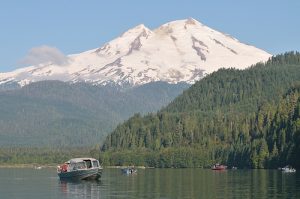
Mount Baker looms in the background of Baker Lake where sockeye fishing is expected to be good later this summer. Photo courtesy of David Kim.
Nibbles and bites
The Lake Washington sockeye count hit 98,146 surpassing the 77,292 pre-season forecast! Through Sunday the run was still behind 119,496 in 2006 when the last sport fishery occurred.
Recent single-day counts were: July 9, 4,777; July 8, 4,721; July 7, 5,496; July 6, 2,126; July 5, 5,562; July 4, 7,466; July 3, 5,411; July 2, 6,286; July 1, 4,481; June 30, 3,877; June 29, 5,585; June 28, 3,614; June 27, 4,665; June 26, 4,319; June 25, 3,482; June 24, 2,797; June 23, 4,342. Spawning goal is 350,000, but late word is fisheries officials could drop it to 200,000 if the run nears that mark. Now tracking between 150,000 and 200,000. Look for it to peak this week. Fingers crossed!
According to Aaron Bosworth a state fisheries biologist they ran a model to see what the end of season run would look like at it was hovering at 149,000, but he noticed the counts were still holding in there and while nothing was hitting the 10,000 single-day counts they saw 6,000-plus fish day which is pretty good. He said it might be higher at more like 150,000 or 200,000. He says it still too soon to say which way this run will go, and didn’t see any evidence the run is peaking just yet.
The state and tribes were talking this past week about trying to finalize that 200,000 fish spawning threshold and wanted to finish that up as soon as possible if the counts continue to climb toward that updated magical number.
One more week should give us a lot more information Bosworth said. “It started to come in early this summer, and in 2013 and 2015,” he said. “I think in those two years it came in really early and they thought it was a huge run and then it petered out to 150,000 and 180,000 which is still a decent return.”
The timing on the returns seems a lot earlier than historical figures show, and Bosworth thinks this run is kind of similar and he just doesn’t see it going big like in 2006. But it is certainly a strong year and a good return to the hatchery and he’s definitely excited about that.
Up north the Baker River fish-trap has 4,663 sockeye and 2,714 transferred to Baker Lake (which is now open for fishing, but was somewhat on the spotty this past weekend). Counts: 545 on 7/9; 546 on 7/8; 663 on 7/7; 645 on 7/6; 315 on 7/5; 318 on 7/4; 395 on 7/3; 179 on 7/2; 122 on 7/1; 53 on June 30; 152 on 6/29; 213 on 6/28; 150 on 6/27; 132 fish on 6/26; 74 on 6/25; 49 on 6/24; 34 on 6/23; 25 on 6/22; and 14 on 6/21. The pre-season, state and tribal biologists produced an estimate run of 47,000.
The Skagit River fishery is open, but closed July 11 to avoid gear conflict with tribal fisheries. Netting dates may change so checkhttps://fortress.wa.gov/dfw/erules/efishrules/.
“Sockeye fishing got a little better in the Skagit River, but not spectacular,” said Brett Barkdull, a state Fish and Wildlife biologist. “The so-so fishing had more to do with clearer water conditions instead of the bad conditions. In fact we’ve got four foot of visibility. It is a beautiful steelhead green color, and that doesn’t equate to good plunking conditions.”
“It will take the fish we do plant on those a couple of days to acclimate, and they aren’t very bitable,” Barkdull said. “If I were to look at the opener it would be like finding a needle in the haystack. They aren’t late coming back and last year was incredibly early. In most years the peak of the run is July 16 and around half of the fish will arrive right around that time frame. We are just on the beginning of the front end of the run. I’d say the third week of this month is when the fishing will really turn on at Baker Lake.”


